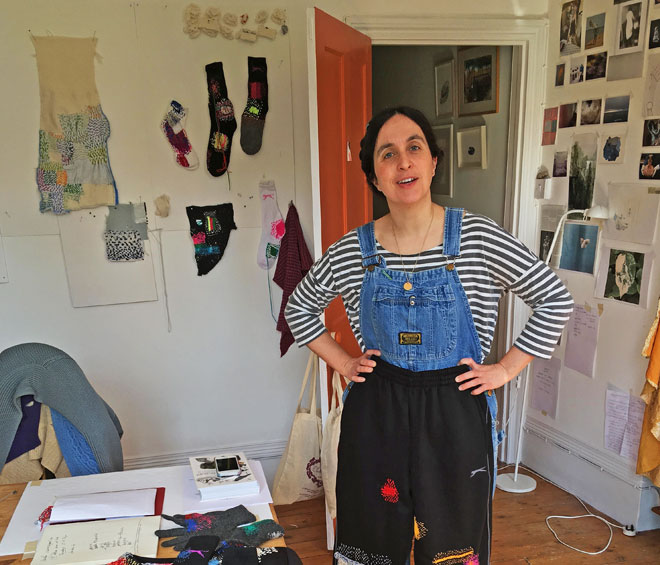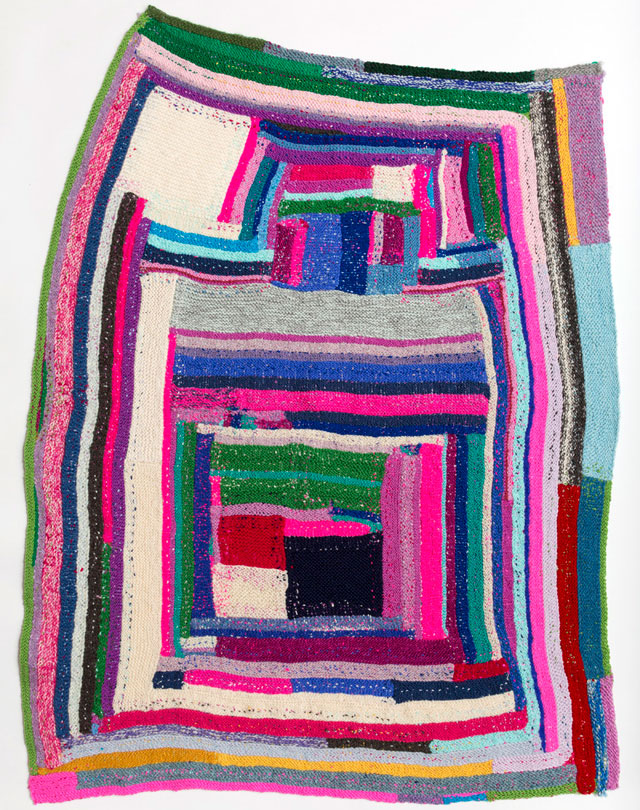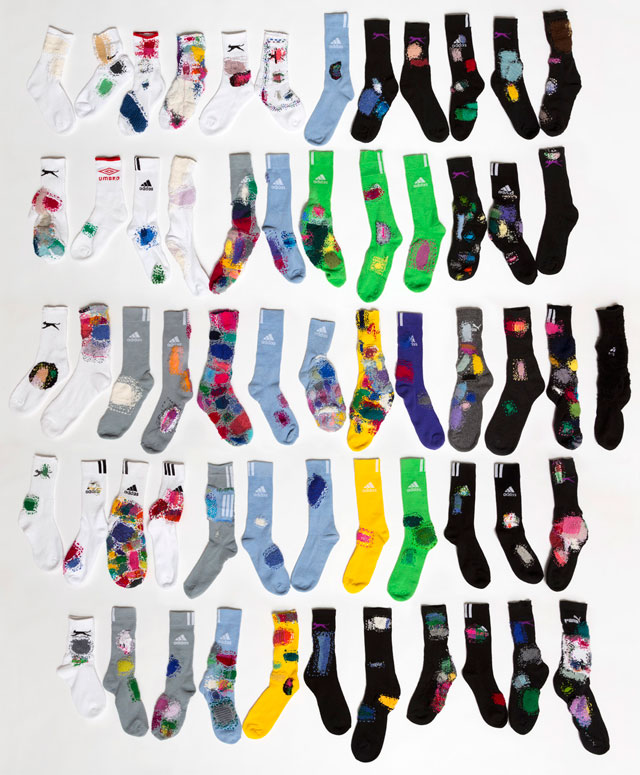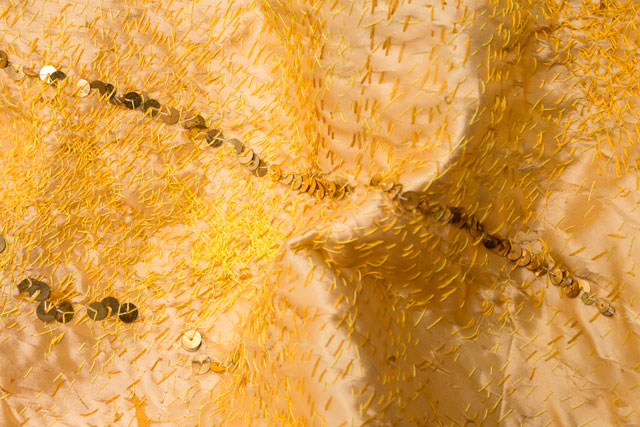
by JANET McKENZIE
Celia Pym (b1978) is a textile artist who employs mending to communicate, usually through favourite garments of clothing. Having studied sculpture at Harvard, obtained a diploma of education at University College London and an MA in constructed textiles at the Royal College of Art, London, she then went on in her early 30s to train as a nurse. She believes that the process of repairing a treasured garment is a form of nurturing, that it is easier to communicate through an object when discussing loss with a stranger. Time, she says, is visible in a person’s clothing, and repairing it is essentially about preserving a relationship. Her interest was triggered when she inherited a jumper that had belonged to her great-uncle, Roland Pym (1910-2006), an artist, theatre designer and illustrator, and which had been mended by his sister, her great-aunt Elizabeth Cobb.
More recently, she has been commissioned by the Nouveau Musée National de Monaco to repair damaged clothing and costumes that were in storage from Les Ballets de Monte-Carlo and then to employ the garments as key aspects of new performances in Iceland and Monaco. Pym acknowledges that in the process of mending she is, in fact, mending more than just the garment. The process enables people to approach her for advice and also to talk candidly about the meaning implied in restoring a treasured piece of clothing. Sometimes, the garment will have been the property of a loved one who has died, so repairing it, she says, enables the relationship to continue. The act of mending artfully is a form of caring and memorialisation.

Celia Pym. Work in progress - Where Holes Happen, 2018. Photograph: Janet McKenzie.
Janet McKenzie: Your mother is from the US. Have you been influenced by the American women’s art of quilt-making, sewing and craft?
Celia Pym: Three generations ago, my mother’s family were from Lithuania and Romania and had shops. One set of great-grandparents had a department store in New Hampshire that sold fabric and haberdashery, the other pair of great-grandparents, also in New Hampshire, had a store that tailored women’s clothing. I have two rag rugs and a quilt made by my great-grandmothers. Someone asked me recently how I got into textiles, so I have been thinking about it. It is not always the case that family background is the reason for getting into the work you do in your life but, in my case, my family were makers. I grew up seeing people knitting and making things. There was evidence in my childhood of rugs and blankets, cross-stitch and furniture, and gardens of past generations of women who had a fantastic range of making skills. Their respective objects were quite particular – a cross-stitch covered brick door stopper possessed a very different quality from a rag rug so I could immediately recognise who had made what. The makers and objects are not recorded in books because they were not created in places where history is told, yet a family’s history is very often told through artefacts.
JMcK: Having written about drawing, it is tempting to label pieces such as a large piece of sculpture made from knitting as spatial drawing. Do you identify with that or do you feel closer to craft?
CP: I studied sculpture first and came to knitting and textiles later. I say that I am an artist who works in textiles. Finished objects can be sculptures or drawings or studies. I love Eva Hesse’s work as much as I love Anni Albers and Nick Cave. The roots for my creative life spread between textiles and sculpture. The Anni Albers exhibition that is coming to Tate Modern (from Bilbao) will be a great opportunity to see the commitment to the craft and the values she placed on the skill, which came from the Bauhaus. I admire her work aesthetically: its seeming simplicity, how she would sort of draw sometimes in her cloth. Let the line lead. I admire how teaching was integral to her making. I saw a great show, called Small-Great Objects: Anni and Josef Albers in the Americas, at Yale University Art Gallery last year, which paired objects they had collected from travelling in Latin and South America with studies, drawing and works of theirs. To many artists who work in textile or craft fields today, craftsmanship is as important as artistry; it requires practice, and a discipline to your material.

Celia Pym. Hope's Sweater 1961, 2011. Photograph: Michele Panzeri.
The 2015 exhibition Indigenous Australia: Enduring Civilisation, at the British Museum, included objects, such as baskets, with videos showing how they were made. The makers appeared so casual about their skill; they had day jobs and did the baskets after hours, in their spare time. I experienced a strange feeling of envy: watching a video of Abe Muriata making a bicornual basket, it looked really fun, complicated, and his hands moved so gracefully and easily. I was envious of the fluidity, confidence and easy way he handled the materials and wove the basket. The baskets in that exhibition that touched me have all been touched by the maker, held and worked by hand with mostly natural materials.
Motive/ Motif, the exhibition that will take place in July in London, organised by Charlotte Hodes at London College of Fashion to commemorate the suffragettes, has been an interesting one for me. Charlotte presented a group of artists with an image of a handkerchief stitched by suffragettes imprisoned at Holloway in 1912 and she invited 20 artists to make a response to it. She wanted the artists to send a design that would then be reproduced using digital embroidery machines. I said yes automatically. The object was so moving, and how great to have a relationship to the object. This was a great project for me.

Celia Pym. You can't always be a beginner, 2014. Photograph: Michele Panzeri.
As I thought about it, the flatness of the drawing felt problematic. I couldn’t get my head around sending a drawing to be embroidered. I’ve used digital machines but I felt reluctant because I am a stitcher and a knitter and I kept thinking I could not understand the translation process. I felt that the drawing would change in the digital process, and that drove a wedge between my idea and the creative process. I’m not against the machine, but on this occasion a friend said: “Why do you have to use the machine. Why can’t you do your own stitching?” Later, Charlotte asked: “Why did you feel the need to subvert our project?” I didn’t think about it like that. The machine can do mesmerising work and it does make beautiful pieces, but the process of the making is very much based on the screen and the machine translates the image to the next stage. It is the middle stage on the screen that I can’t connect with.
So much of my work relates to my own body so the machine and the screen is where I lose the connection.
JMcK: Can you explain the work you have done recently at the Victoria and Albert museum as part of the Woman’s Hour Craft programme?
CP: People would bring their garments with holes in and I would mend them. I did all these at a consultation table. It was a surgery for mending. Every time I did a mend, I would make a corresponding hole in this piece – and mend it the same way, giving a record of the original repair. The idea was to mark out, or map, how all the damage was made.

Celia Pym. First one's the best, 2015. Photograph: Michele Panzeri.
JMcK: You mend beautiful handmade sweaters, but you also repair sports garments made from synthetic as opposed to natural yarns?
CP: Tracksuits are good to work with because they don’t fray – the humour of it appealed to me when I started working with them – and I started because of the 2012 Olympics in London and then just grew to love them – the mark on the tracksuit. I’m not sporty, so the unsporty sportiness of these things was amusing, and the end product is very beautiful – an ordinary piece of fabric is transformed into a work of art. One of the things that I love about darning is that you are faced with a problem, an edge that is very damaged and it is not a case of designing that form. Rather, you respond to it. It often seems impossible (beyond one’s skills), but you can solve it if you inch your way in.
Years ago, I liked the sense of making visible rather than invisible mending. I didn’t ever see the point of invisible mending. It seemed more important to see the repair, see the damage. Damage and repair go hand in hand.
JMcK: Ruby Wax describes female memory as making us who we are. Do you think that your forebears did this kind of work and that, in making your work, you are connecting with them?
CP: I think about the female experience and how it is different, or not different, from male experience, but I don’t consciously address it in my work. I am most interested in the home spaces as a place to find materials and objects that inspire and interest me. For instance, well-worn clothes that you might not wear outdoors but you slip into as soon as you are home, favourite rugs and spoons, modified measuring tools and fixed wedges that hold doors open, or beloved artwork made my children. I am interested in craft skills that take place in the home and that are shared through watching and knowing. Like a private apprenticeship, in your home, you learn to mend things, make things, cook, garden, clean, build. Mending represents an implied understanding of process and family values rather than an explicit form of teaching or learning. This cardigan came from a house clearance – there’s a lot of detective work, you’re looking at something that someone wore, and you are focusing on a hole in an elbow that someone wore and moved in.
The damage in a garment is the echo of the physicality of the body. It is why the clothes of the people we have loved are particularly important. I mend things that are often cosy clothes, not the best clothes. It is what is inside the clothing, not the external appearance, that I am exploring. I largely mend women’s clothes.
This is a child’s sweater from the 50s from Germany, then it was my brother’s. The mending section is about absences; it’s the shape of an island, I am making a solid form from an absence.
JMcK: Can you tell me about this remarkable sweater that belonged to your great-uncle?
CP: This is the sweater that belonged to my great-uncle Roland Pym and was mended by his sister, Elizabeth Cobb. It was given to me after he died in 2006. It kicked off my interest in mending. The sweater was hand-knitted by his sister (they had lived together) and both of them were single for most of their adult lives. What I like are things that are a bit wrong, slightly asymmetrical. The blue mending is mine and all the white or cream was done by my aunt. I was very moved by the whole garment. There are lots of different yarns and the thought of her slowly taking care of things was moving to me, that she paid attention and persistently patched and darned. I love her ready style and the practical nature of her repairs. She died before him and when I got the sweater, there were many new holes that she had not had a chance to mend. I don’t think it had a front and a back. He was a painter and he died in his late 90s and in the latter period of his life he just sat in a chair drawing.

Roly's sweater, mended by Elizabeth. Photograph: Janet McKenzie.
JMcK: So you have immortalised his art process?
CP: I don’t think of it that way. I was learning from her and her darning. And thinking about both of them while I did it.
JMcK: The life of fabrics can be quite random and your processes are often experimental?
CP: There is a sense that damage and use cannot be faked.
JMcK: What are you doing in Iceland this month?
CP: I am travelling there with a gold cape that I have mended. It belongs to the Nouveau Musée National de Monaco and, originally, possibly belonged to the Ballets Russes. The actual origin is unknown, but it came bundled with other costumes that were part of the Ballets Russes. It was made from an old golden silk with sequins, and, over time, it had started to rot and was terribly dusty. The whole piece was very fragile.

Celia Pym. Flying Gold Cape (detail), 2016-18. Photograph: Michele Panzeri.
I mended it on a residency in Iceland and now I’m taking it back there for a number of performances. The initial stages are on my website: http://celiapym.com/work/59-sorties-gold-cape-blonduos/
Fifty-nine costumes were destined to exit the collection in Monaco because they were in such a poor state, and I said: “If they are in this indeterminate state, neither for display or for throwing away but no one knew what to do with them, can I use them?” They didn’t want to chuck them out, but they just sat in the store not being viewed. There is a limit to how many artworks can be stored. They are designed to be part of a performance, so I have taken them out, worked on them and am using them until they fall apart. Use and living – the cape will go to Iceland, then to the opera house in Monaco and also to schools. I thought when I had I mended it: “What do I do now?” That was the conversation we were having. It’s really a magical cape and I stitched it on to a cotton ground. The sequins were basically keeping it together.